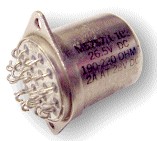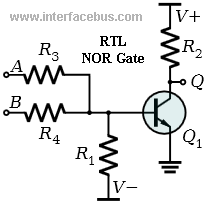Engineering Dictionary of Electronic Terms
"A"
"B"
"C",
"D",
"E",
"F",
"G",
"H",
"I",
"J",
"K",
"L",
"M",
"N",
"O",
"P",
"Q",
"R",
"S",
"T",
"U",
"V",
"W",
"X",
"Y",
"Z"
"R" to "Rad",
"Rai" to "Rea",
"Rec" to "Relat",
"Relay" to "Resol",
"Reson" to "Rh",
"Ri" to "Rm",
"Ro" to "Rz"
Relay. An electromagnetic device with one or more sets of contacts that change position by the magnetic attraction of a coil to an armature. Related; Relay Manufacturers. A relay is a low-powered device used to activate a high-powered device. |  Relay |
 Relay Schematic | An electromechanical or semiconductor switch (i.e., solid-state relay) in which a current or voltage applied across one port or terminal controls electrical currents or voltages that appear across another terminal or terminals. |
A protective or control device which completes or breaks an electrical circuit in response to electrical changes in an external circuit. The main contacts and actuating element are not in series. A relay is not designed to permit manual opening of the protected or controlled circuit but may have facilities for manual closing or reset upon automatic opening of the circuit. A relay is classified by the type of contact actuation, such as electromagnetic or thermal, or by a type of construction, such as resonant reed or solid state, rather than by its application.
Relay Driver. An integrated circuit designed to handle the large load of a relay. An IC that can sink a heaver than normal amount of current.
Reliability. The ability of an item to perform a required function under stated conditions for a specified period of time. The probability that a functional unit will perform its required function for a specified interval under stated conditions.The probability of a part performing its specified purpose for the period
intended under the operating conditions encountered, expressed as failure rate. Also refer to MTBF.
Reluctance. A measure of the opposition that a material offers to magnetic lines of force.
Remote-Cutoff Tube. An electron tube in which the control grid wires are farther apart at the
centers than at the ends. This arrangement allows the tube to amplify large signals without being driven
into cutoff. [VARIABLE-MU TUBE].
|
Rheostat: A two terminal variable resistor, or a three terminal variable resistor in which the wiper and one end terminal is used. However good design practice dictates that the unused terminal should be tied to the wiper contact. |  Rheostat |
Repeater. A station that receives a signal [on one frequency] and re-transmits the signal [on another frequency] over the air. A device that regenerates the incoming signal to the original signal level, and than retransmits that signal to increase the distance the signal can travel.
An analog device that amplifies an input signal regardless of its nature, i.e., analog or digital. A digital device that amplifies, reshapes, retimes, or performs a combination of any of these functions on a digital input signal for retransmission.
Repeller. [Reflector]. An electrode in a reflex klystron with the primary
purpose of reversing the direction of the electron beam.
Reproduction. The process of converting electrical signals to sound waves. This sound is speech,
music, and so on.
Repulsion. The mechanical force tending to separate bodies having like electrical charges or like
magnetic polarity.
Reradiation. The reception and retransmission of radio waves that is caused by turbulence in the
troposphere.
Residual Magetism. Magnetism remaining in a substance after removal of the magnetizing force.
Resistance. The opposition a device or material offers to the flow of current. The effect of resistance is to raise the temperature of the material or device carrying the current. A circuit element designed to offer a predetermined resistance to current flow. A resistance of 1 ohm will allow a current of 1 ampere to flow through it when a potential of 1 volt is applied. R = E/I.
Resistance Wire. A single, bare or insulated, metallic conductor specifically designed to limit the flow of current in an electrical circuit. Its resistance relative to copper of the same cross-sectional area is high.
Resistivity. The reciprocal of conductivity.
Resistor. The electrical component that offers resistance to the flow of current. It may be a coil of fine
wire or a composition rod. [Resistor Definitions, Resistor Manufacturers]
Resistor-Capacitor Filter. An RC Filter.
Resistor Decade [Box]. An adjustable assembly of precision resistors in decimal steps, inclosed in a box and provided with a means of selecting any multiple of the least unit up through the aggregate of all units.
Resistor-Transistor Logic. [RTL] An out-dated form of logic which used a resistor as the input component, which was connected to the Base of an NPN transistor. A digital logic family that predated Transistor Transistor Logic [TTL].
Resolution. The degree to which a measurement can be determined. The minimum difference between two discrete values that can be distinguished by a measuring device.
Resonant Line. A transmission line that has current or voltage standing waves.
Resolver. A rotary, electromechanical device used to perform trigonometric computations by varying
the magnetic couplings between its primary and secondary windings. A resolver is generally used in circuits that solve vector problems, such as analog computers and conversion equipment.












